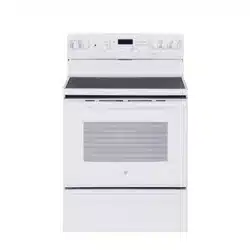Documents: Go to download!
- User Manual - (English, French)
- Operating Instructions
- Care and Cleaning
- Troubleshooting
Table of contents
OWNER GUIDE Electric Ranges
Operating Instructions
Using the radiant surface units. (on some models)
NOTE: Throughout this manual, features and appearance may vary from your model.
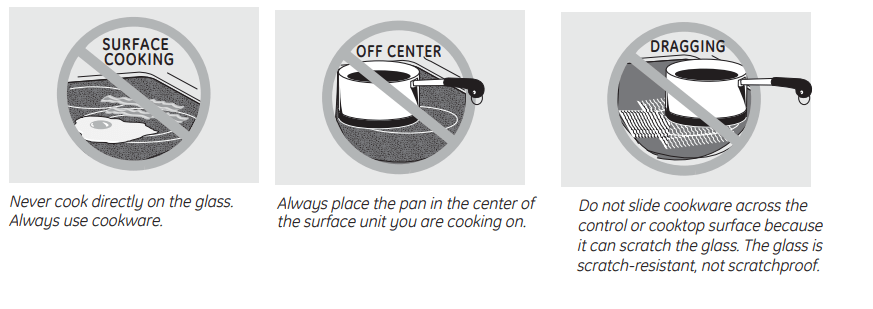
About the Radiant Surface Units
WARNING: all surface unit controls are turned off at all times during the self-clean cycle. Wait until the self-clean cycle is finished to set and use the surface units. The radiant cooktop features heating units beneath a smooth glass surface. Cooktop temperatures increase with the number of surface units that are on. With 3 or 4 units turned on, surface temperatures are high. Always use caution when touching the cooktop. An indicator light will come on when the surface unit is turned on. The appropriate HOT surface indicator light will glow when its corresponding radiant element is turned on and will remain on until the surface has cooled below 65.5°C (150°F).
NOTE:
Hot surface indicator light will:
- Come on when the surface unit is hot to the touch.
- Stay on even after the unit is turned off.
- Glow brightly until the unit has cooled below 65.5°C (150°F).
NOTE: A slight odor is normal when a new cooktop is used for the first time. It is caused by the heating of new parts and insulating materials and will disappear in a short time.
NOTE: On models with light-colored glass cooktops, it is normal for the cooking zones to change color when hot or cooling down. This is temporary and will disappear as the glass cools to room temperature.
It is safe to place hot cookware from the oven or surface on the glass cooktop when the surface is cool.
Even after the surface units are turned off, the glass cooktop retains enough heat to continue cooking. To avoid overcooking, remove pans from the surface units when the food is cooked.
Avoid placing anything on the surface unit until it has cooled completely.
- Water stains (mineral deposits) are removable using the cleaning cream or full strength white vinegar.
- Use of window cleaner may leave an iridescent film on the cooktop. The cleaning cream will remove this discoloration.
- Don’t store heavy items above the cooktop. If they drop onto the cooktop, they can cause damage.
- Do not use the surface as a cutting board
Temperature Limiter
Every radiant surface unit has a temperature limiter.
The temperature limiter protects the glass cooktop from getting too hot.
The temperature limiter may cycle the units for a time if:
- The pan boils dry.
- The pan bottom is not fiat.
- The pan is off center.
- There is no pan on the unit.
Selecting types of cookware
The following information will help you choose cookware which will give good performance on glass cooktops.
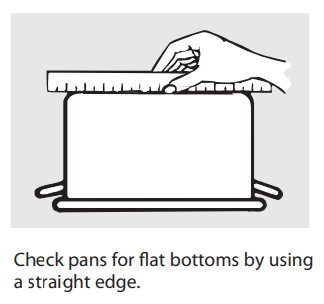
Stainless Steel:
recommended
Aluminum:
heavy weight recommended Good conductivity. Aluminum residues sometimes appear as scratches on the cooktop, but can be removed if cleaned immediately. Because of its low melting point, thin-weight aluminum should not be used.
Copper Bottom:
recommended
Copper may leave residues which can appear as scratches. The residues can be removed, as long as the cooktop is cleaned immediately. However, do not let these pots boil dry. Overheated metal can bond to glass cooktops. An overheated copper bottom pot will leave a residue that will permanently stain the cooktop if not removed immediately.

Porcelain Enamel-Covered Cast Iron:
recommended
As long as the cookware is covered completely with porcelain enamel, this cookware is recommended. Caution is recommended for cast-iron cookware that is not completely covered with .smooth porcelain enamel, as it may .scratch the glass-ceramic cooktop.
Glass-Ceramic:
usable, but not recommended
Poor performance. May scratch the surface.
Stoneware:
usable, but not recommended
Poor performance. May scratch the surface.
Home Canning Tips:
Be sure the canner is centered over the surface unit.
Make sure the canner is flat on the bottom.
Use recipes and procedures from reputable sources. These are available from manufacturers such as Ball® and Kerr® and the Department of Agriculture Extension Service.
To prevent burns from steam or heat, use caution when canning.
The following information will help you choose cookware which will give good performance on coil cooktops.
Surface Cookware Tips
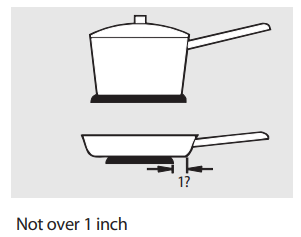
Use medium- or heavy-weight cookware. Aluminum cookware conducts heat faster than other metals. Cast-iron and coated cast-iron cookware are slow to absorb heat, but generally cook evenly at low to medium heat settings. Steel pans may cook unevenly if not combined with other metals.
For best cooking results, pans should be flat on the bottom. Match the size of the saucepan to the size of the surface unit. The pan should not extend over the edge of the surface unit more than 2.5 cm 1 inch.
Wok Cooking

We recommend that you use only a flat-bottomed wok. They are available at your local retail store.
Do not use woks that have support rings. Use of these types of woks, with or without the ring in place, can be dangerous.
Placing the ring over the surface unit will cause a buildup of heat that will damage the porcelain cooktop. Do not try to use such woks without the ring. You could be seriously burned if the wok tips over.
Using the surface units.
Throughout this manual, features and appearance may vary from your model.
How to Set

Push the knob in and turn in either direction to the setting you want.
At both OFF and Max the control clicks into position. You may hear slight clicking sounds during cooking, indicating the control is keeping the power level you set.
Indicator Lights (on radiant glass models only)
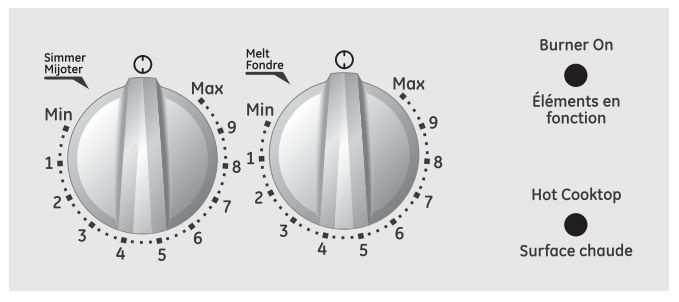
A Hot indicator light will glow when any radiant element is turned on, and will remain on until the surface is cool enough to touch.
A Burner On indicator light will glow when any surface unit is on.
NOTE: The Hot indicator light may glow between the surface control settings of Min and OFF, but there is no power to the surface units.
Using the oven controls.
NOTE: Throughout this manual, features and appearance may vary from your model.
Features and appearance may vary. Control graphics for general artworks.
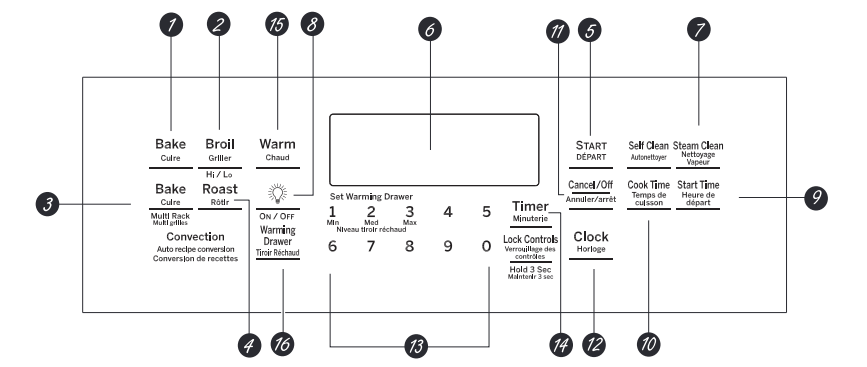
Control graphics for JCB840, JCB870 and JCB830 Models.

 Oven Control, Clock and Timer Features and Settings
Oven Control, Clock and Timer Features and Settings
 BAKE Pad
BAKE Pad
Touch to select the bake function.
 BROIL Pad
BROIL Pad
Touch to select the broil function.
 CONVECTION BAKE Pad
CONVECTION BAKE Pad
Touch to select baking with the convection function.
 CONVECTION ROAST Pad Touch to select roasting with the convection function.
CONVECTION ROAST Pad Touch to select roasting with the convection function.
 START Pad
START Pad
Must be touched to start any cooking or cleaning function.
 Display
Display
Shows the time of day, oven temperature, whether the oven is in the bake, broil or self-cleaning mode and the times set for the timer or automatic oven operations.
If "F- and a number or letter" flash in the display and the oven control signals, this indicates a function error code. Touch the OFF pad. Allow the oven to cool for one hour. Put the oven back into operation. If the function error code repeats, disconnect the power to the oven and call for service.
If your oven was set for a timed oven operation and a power outage occurred, the clock and all programmed functions must be reset.
The time of day will flash in the display when there has been a power outage.
 CLEAN Pad
CLEAN Pad
Touch to select self-cleaning function.
See the Using the self-cleaning oven section.
 LIGHT Pad
LIGHT Pad
Touch to turn the oven light on or off.
 START TIME Pad
START TIME Pad
Use along with COOK TIME or CLEAN pads to set the oven to start and stop automatically at a time you set.
 COOK TIME Pad
COOK TIME Pad
Touch and then touch the number pads to set the amount of time you want your food to cook. The oven will shut off when the cooking time has run out.
 OFF Pad
OFF Pad
Touch to cancel ALL oven operations except the clock and timer.
 CLOCK Pad
CLOCK Pad
Touch before setting the clock.
 Number Pads
Number Pads
Use to set any function requiring numbers such as the time of day on the clock, the timer, the oven temperature, the internal food temperature, the start time and length of operation for timed baking and self-cleaning.
 TIMER Pad
TIMER Pad
Touch to select the timer feature.
 PROOF Pad
PROOF Pad
Touch to select a warm environment useful for rising yeast-leavened products.
 WARMING DRAWER ON/OFF Pad Touch to select the warming drawer function.
WARMING DRAWER ON/OFF Pad Touch to select the warming drawer function.
Temperature Conversions
 Using the oven.
Using the oven.
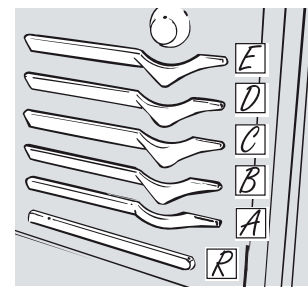
The oven has 5 rack positiones. It also has a special low rack position (R) for extra large items, such as a large turkey.
Before you begin...
The racks have stops, so that when placed correctly on the supports, they will stop before coming completely out, and will not tilt.
When placing and removing cookware, pull the rack out until it stops.
To remove a rack, pull it toward you, tilt the front end up and pull it out.
To replace, place the end of the rack (stop-locks) on the support, tilt up the front and push the rack in.
How to Set the Oven for Baking or Roasting
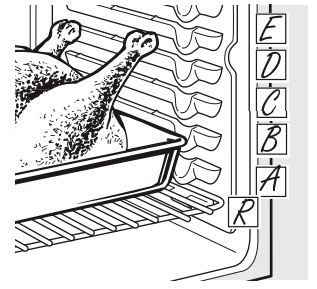
- Touch the BAKE pad.
- Touch the number pads to set the desired temperature.
- Touch the START pad.
- Check food for doneness at minimum time on recipe. Cook longer if necessary.
- Touch the OFF pad when cooking is complete.
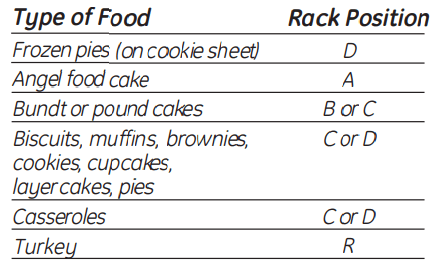
Preheating and Pan Placement
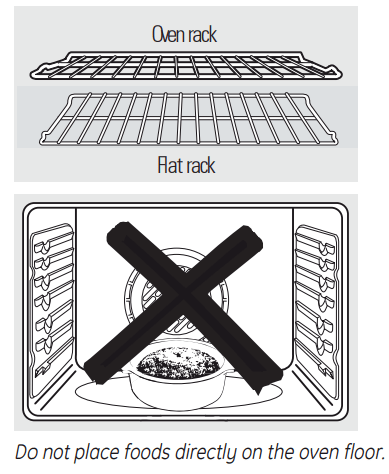
Preheat the oven if the recipe calls for it. Preheating is necesary for good results when baking cakes, cookies, pastry and breads. To preheat, set the oven at the correct temperature. The control will beep when the oven is preheated an the display will show your set temperature.
Baking results will be better if baking pans are centered in the oven as much as possible. If baking with more than one pan, place the pans so each has at least 2.5 cm to 3.8 cm (1" to 11/2") of air space around it.
If baking four cake layers at the same time, place two layers on rack B and two layers on rack D. Stagger pans on the rack so one is not directly above the other.
Aluminum Foil
Do not use aluminum foil on the bottom of the oven. Never entirely cover a rack with aluminum foil. This will disturb the heat circulation and result in poor baking.
A smaller sheet of foil may be used to catch a spillover by placing it on a lower rack several inches below the food.
How to Set the Oven for Broiling
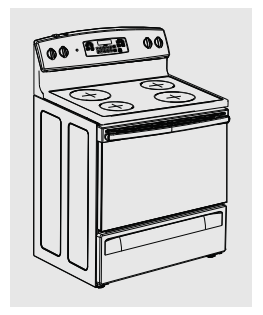
NOTE: Close the door before start any broiling function.
Use LO Broil to cook foods such as poultry or thick cuts of meat thoroughly without over browning them.
- Place the meat or fish on a broiler grid in a broiler pan designed for broiling.
- Follow suggested rack positions in the Broiling Guide.
- Touch the BROIL HI/LO pad once for HI Broil.
To change to LO Broil, touch the BROIL HI/LO pad again. - Touch the START pad.
- When broiling is finished, touch the CLEAR/OFF pad.
The size, weight, thickness, starting temperature and your preference of doneness will affect broiling times. This guide is based on meats at refrigerator temperature
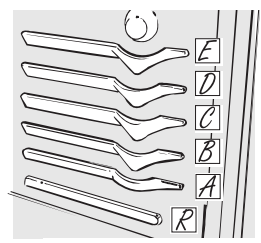
The oven has aspecial lower rack(R) position just above theoven bottom. Use it when extra cooking space is needed, for example, when cooking a large turkey. The rack is not designed to slide out at this position.
Broiling Guide
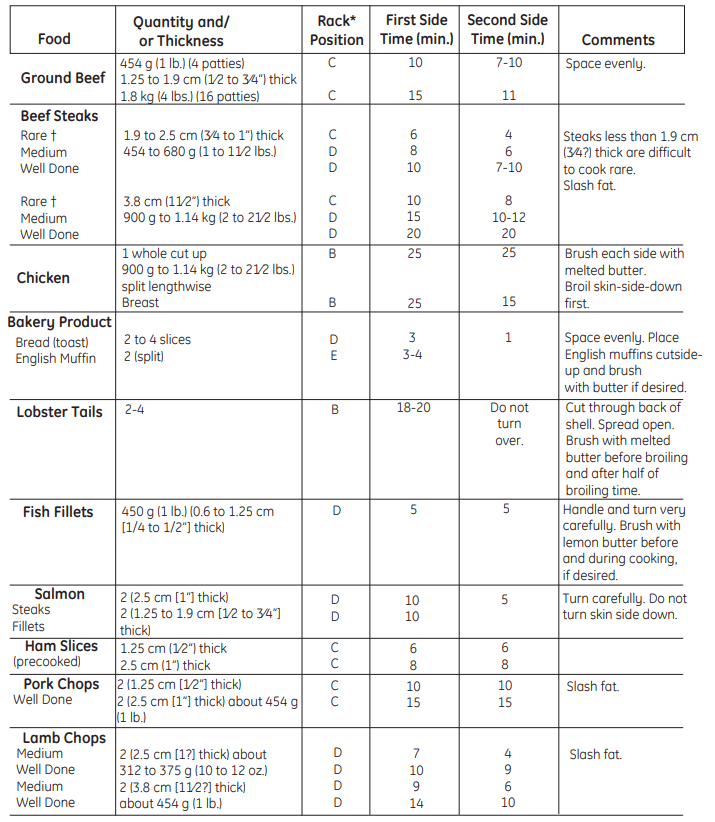
*See illustration for description of rack positions.
Using the timed baking and roasting features
NOTE: Foods that spoil easily³such as milk, eggs, fish, stuffings, poultry and pork³should not be allowed to sit for more than 1 hour before or after cooking. Room temperature promotes the growth of harmful bacteria. Be sure that the oven light is off because heat from the bulb will speed harmful bacteria growth
How to Set an Immediate Start and Automatic Stop
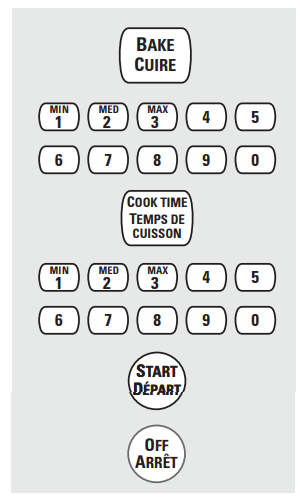
The oven will turn on immediately and cook for a selected length of time. At the end of the cooking time the oven will turn off automatically
- Touch the BAKE pad.
- Touch the number pads to set the desired oven temperature.
- Touch the COOK TIME pad.
NOTE: If your receipe requires preheating, you may need to add additional time to the lenght of the cooking time. - Touch the number pads to set the desired length of cooking time. The minimum cooking time you can set is 1 minute.
The oven temperature that you set and the cooking time that you entered will be in the display. - Touch the START pad.
NOTE:An attention tone will sound if you are using timed baking and do not touch the START pad. The ovenwill turn ON, and the display will show the cooking time countdown and the changing temperature starting at 37.8 °C (100 °F). (The temperature display will start to change once the oven temperature reaches 37.8 °C [100 °F]). When the oven reaches the temperature you set, 3 beeps will sound. The oven will continue to cook for the set amount of time, then turn off automatically. - Touch the OFF pad to clear the display if necessary. Remove the food from the oven. Remember, even though the oven turns off automatically, food left in the oven will continue cooking after the oven turns off
How to Set a Delayed Start and Automatic Stop

The oven will turn on at the time of day you set, cook for a specific lenght of time an then turn off automatically. How to Set an Immediate Start and Automatic Stop The oven will turn on immediately and cook for a selected length of time. At the end of the cooking time the oven will turn off automatically Make sure the clock shows the correct time of day.
- Touch the BAKE pad.
- Touch the number pads to set the desired oven temperature.
- Touch the COOK TIME pad.
NOTE: If your receipe requires preheating, you may need to add additional time to the length of the cooking time. - Touch the number pads to set the desired length of cooking time. The minimum cooking time you can set is 1 minute. The oven temperature that you set and the cooking time that you entered will be in the display
- Touch the START TIME pad.
- Touch the number pads to set the time of day you want the oven to turn on and startcooking.
- Touch the START pad.
NOTE: An attention tone will sound if you are using timed baking and do not touch the START pad.
NOTE: If you would like to check the times you have set, touch the S TART TIME pad to
COOK TIME pad to check the lenght of cooking time you have set.
When the oven turns ON at the time of day you set, the display will show the cooking time countdown and the changing temperature starting at 37.8°C (100 °F). (The temperature display will start to change once the oven temperature reaches 37.8 °C [100°F]). When the oven reaches the temperature you set, 3 beeps will sound.
The oven will continue to cook for the set amount of time, then turn automatically. - Touch the OFF pad to clear the display if necessary. Remove the food from the oven. Remember, even though the oven turns off automatically, food left in the oven will continue cooking after the oven turns off.
Using the warming drawer.(on some models)
The warming drawer will keep hot, cooked foods at serving temperature. Always start with hot food. Do not use to heat cold food other than crisping crackers, chips or dry cereal.

To Use the Warming Drawer
- Touch the WARMING DRAWER pad. “WARMERON” and “1” are lit on the display and “Set” begins to blink.
- On the number pad, touch 1 for Min, 2 for Med or 3 for Max. The display “1” changes corresponding to the number pad selected.
- The warming drawer starts automatically after touching 1 , 2 or 3. “WARMERON” and the number remain lit. “Set” stops blinking.
To cancel, touch the WARMING DRAWER pad
NOTE: Touching the OFF pad does not turn the warming drawer off.
NOTES:
- The warming drawer has three settings: 1, 2 and 3. These settings maintain different temperature levels in the warming drawer.
- On some models, if using the oven at the same time as the warming drawer, only the oven settings will be displayed.
- The warming drawer cannot be used during a self-cleaning cycle.
When Using the Warming Drawer
The warming drawer will keep hot, cooked foods warm. Always start with hot food. Do not use to heat cold food other than crisping crackers, chips or dry cereal.
Do not line the warming drawer or pan with aluminum foil. Foil is an excellent heat insulator and will trap heat beneath it. This will upset the performance ofthe drawer and could damage the interior finish.
Allow approximately 25 minutes for the warming drawer to preheat.
- Do not put liquid or water in the warming drawer.
- All foods placed in the warming drawer should be covered with a lid or aluminum foil. When warming pastries or breads, the cover should be vented to allow moisture to escape.
- Food should be kept hot in its cooking container or transferred to a heat-safe serving dish.
CAUTION: Plastic containers orgiastic wrap will melt if in direct contact with the drawer, pan or a hot utensil. Melted plastic may not be removable and is not covered under your warranty.
- Remove serving spoons, etc., before placing containers in warming drawer.
Temperature Selection Chart
To keep several different foods hot, set the control to the food needing the highest setting.
- The temperature, type and amount of food, and the time held will affect the quality of the food.
- Repeated opening of the drawer allows the hot air to escape and the food to cool.
- With large loads it may be necessary to use a higher warming drawer setting and cover some of the cooked food items.
- Do not use plastic containers or plastic wrap.

To Crisp Stale Items
- Place food in low-sided dishes or pans.
- Preheat on 1 setting.
- Check crispness after 45 minutes. Add time as needed.
To Warm Serving Bowls and Plates
To warm serving bowls and plates, set the control on 1.
- Useonlyheat-safe dishes
- If you want to heatfine china, please check with the manufacturerof the dishes for their maximum heat tolerance.
- You may warm empty serving dishes while preheating the drawer.
CAUTION: Use pot holders or mitts when removing hot dishes.
Using the clock and timer.

Make sure the clock is set to the correct time of day
To Set the Clock
The clock must be set to the correct time of day for the automatic oven timing functions to work properly. The time of day cannot be changed during a timed baking or self-cleaning cycle.
- Touch the CLOCKpad.
- Touch the numberpads.
- Touch the START pad.
To Set the Timer

The Timer is a minute timer only. The Timer does not control oven operations. The maximumsetting on the Timer is 9 hoursand 59 minutes.
- Touch the TIMER pad.
- Touch the number pads until the amount of time you want shows in the display. For example, to set 2 hours and 45 minutes, touch 2, 4 and 5 in that order. If you make a mistake, touch the TIMER pad and begin again.
- Touch the START pad.
After touching the START pad, SET disappears; this tells you the time is counting down, although the display does not change until one minute has passed. Seconds will not be shown in the display until the last minute is counting down - When the Timer reaches :00, the control will beep 3 times followed by one beep every 6 seconds until the TIMER pad is touched.
The 6-second tone can be canceled by following the steps in the Special features of your oven control section under Tones at the End of a Timed Cycle.
To Reset the Timer
If the display is still showing the time remaining, you may change it by touching the TIMER pad, then touch the number pads until the time you want appears in the display. If the remaining time is not in the display (clock, delay start or cooking time are in the display), recall the remaining time by touching the TIMER pad and then touching the number pads to enter the new time you want.
To Cancel theTimer Touch the TIMER pad twice.
Care and Cleaning
Care and cleaning of the range
Be sure electrical power is off and all surfaces are cool before cleaning any part of the range
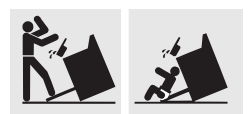
If your range is removed for cleaning, servicing or any reason, be sure the anti-tip device is re-engaged properly when the range is replaced. Failure to take this precaution could result in tipping of the range and cause injury.
Oven Interior (non-self-clean models)
With proper care, the porcelain enamel finish on the inside of the oven—top, bottom, sides, back and inside of the door—will stay new-looking for years.
Let the range cool before cleaning.
We recommend that you wear rubber gloves when cleaning the range.
Soap and water will normally do the job. Heavy spattering or spillovers may require cleaning with a mild abrasive cleaner. Soap-filled scouring pads may also be used.
 Do not allow food spills with a high sugar or acid content (such as milk, tomatoes, sauerkraut, fruit juices or pie filling) to remain on the surface. They may cause a dull spot even after cleaning
Do not allow food spills with a high sugar or acid content (such as milk, tomatoes, sauerkraut, fruit juices or pie filling) to remain on the surface. They may cause a dull spot even after cleaning
Household ammonia may make the cleaning job easier. Place 1/2 cup in a shallow glass or pottery container in a cold oven overnight.
The ammonia fumes will help loosen the burned-on grease and food.
If necessary, you may use an oven cleaner. Follow the package directions.
Do not spray oven cleaner on the electrical controls and switches because it could cause a short circuit and result in sparking or fire.
Do not allow a film from the cleaner to build up on the temperature sensor—it could cause the oven to heat improperly. (The sensor is located at the top of the oven.) Carefully wipe the sensor clean after each oven cleaning, being careful not to move the sensor as a change in its position could affect how the oven bakes.
Do not spray any oven cleaner on the oven door, handles or any exterior surface of the oven, cabinets or painted surfaces.
The cleaner can damage these surfaces.
Cleaning the Oven Door
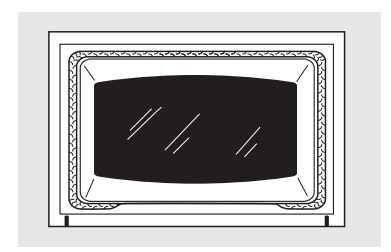
The gasket is designed with a gap at the bottom to allow for proper air circulation. Do not rub or clean the door gasket—it has an extremely low resistance to abrasion. If you notice the gasket becoming worn, frayed or damaged in any way or if it has become displaced on the door, you should have it replaced.
To clean the inside of the door:
- Because the area inside the gasket is cleaned during the self-clean cycle, you do not need to clean this by hand.
- The area outside the gasket and the door liner can be cleaned with a soap-filled or plastic scouring pad, hot water and detergent. Rinse well with a vinegar and water solution.
To clean the outside of the door:
Use soap and water to thoroughly clean the top, sides and front of the oven door. Rinse well. You may also use a glass cleaner to clean the glass on the outside of the door. Do not let water drip into the vent openings.
- If any stain on the door vent trim is persistent, use a soft abrasive cleaner and a sponge-scrubber for best results.
- Spillage of marinades, fruit juices, tomato sauces and basting materials containing acids may cause discoloration and should be wiped up immediately. When surface is cool, clean and rinse.
- Do not use oven cleaners, cleaning powders or harsh abrasives on the outside of the door.
Lift-Off Oven Door(on some models)
The door is very heavy. Be careful when removing and lifting the door.
Do not lift the door by the handle.
To remove the door:
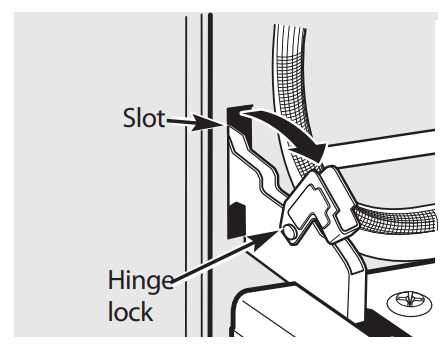
Pull hinge locks down to unlock.
- Fully open the door.
- Pull the hinge locks down toward the door frame, to the unlocked position. A tool, such as a small flat-blade screwdriver, may be required.
- Firmly grasp both sides of the door at the top.
- Close door to the door removal position, which is halfway between the broil stop position and fully closed.
- Lift door up and out until the hinge arm is clear of the slot.
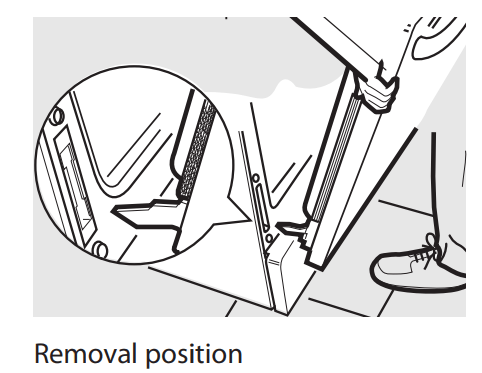
To replace the door:
- Firmly grasp both sides of the door at the top.
- With the door at the same angle s as the removal position, seat the indentation of the hinge arm into the bottom edge of the hinge slot. The notch in the hinge arm must be fully seated into the bottom of the slot.
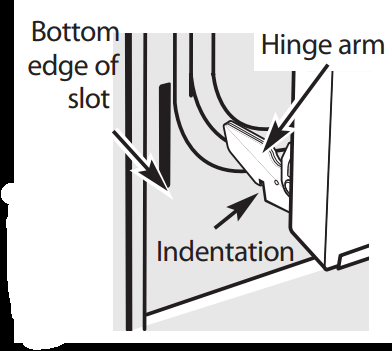
- Fully open the door. If the door will not fully open, the indentation is not seated correctly in the bottom edge of the slot.
- Push the hinge locks up against the front frame of the oven cavity to the locked position.
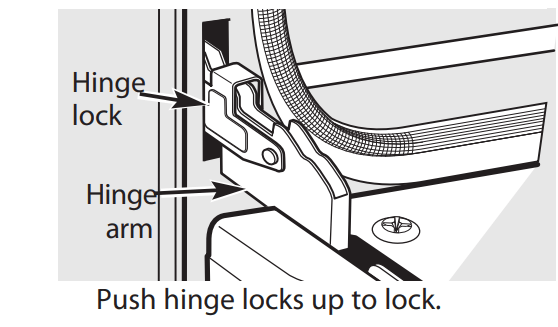
- Close the oven door.
Oven Heating Elements

Do not clean the bake element or the broil element. Any soil will burn off when the elements are heated.
To clean the oven floor, gently lift the bake element Clean with warm soapy water
On some models, the bake element is not exposed and is under the oven floor. If spillover residue or ash accumulate on the oven floor, wipe up before self-cleaning.
Oven Racks
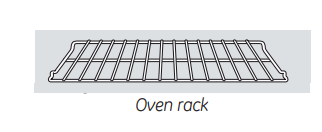
All oven racks may be cleaned by hand with an abrasive cleaner or steel wool After cleaning, rinse the racks with clean water and dry with a clean cloth. Gray porcelain-coated oven racks may remain in the oven during the self-cleaning cycle without being damaged The shiny, silver colored oven racks may remain in the oven during the self-cleaning cycle, but they will lose their luster and become hard to slide.
It will be necessary to grease all oven rack side edges with a light coating of vegetable oil after cleaning them by hand or in the oven. This will help maintain the ease o sliding the racks in and out of the oven.
Oven Light Replacement (on somemodels)
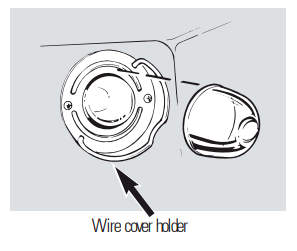
CAUTION: Before replacing your oven light bulb, turn the oven light off and disconnect the electrical power to the range at the main fuse or circuit breaker panel.
Be sure to let the light cover and bulb cool completely.
To remove the cover:
- Hold a hand under the cover so it doesn't fall when released. With fingers of the same hand, firmly push back the wire cover holder. Lift off the cover.
Do not remove any screws to remove the cover - Replace bulb with a 40-watt household appliance bulb
To replace the cover:
- Place it into groove of the light receptacle. Pull wire forward to the center of the cover until it snaps into place.
- Connect electrical power to the range.
Storage Drawer Removal (on somemodels)
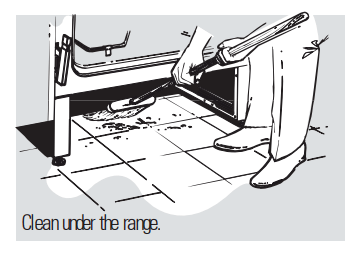
To remove the storage drawer:
- Pull the drawer out all the way.
- Tilt up the front and remove it.
WARNING: Do not leave paper products, plastics canned food or combustible materials in the drawer.
To replace the storage drawer:
- Insert glides at the back of the drawer beyond the stop on range glides.
- Lift the drawer if necessary to insert easily.
- Let the front of the drawer down; then push in to close.
Porcelain Enamel Cooktop (on radiant models)
The porcelain enamel finish is sturdy but breakable if misused. This finish is acid-resistant. However, any acidic foods spilled (such as fruit juices, tomato or vinegar) should not be permitted to remain on the finish.
If acids spill on the cooktop while it is hot, use a dry paper towel or cloth to wipe it up right away. When the surface has cooled, wash with soap and water. Rinse well.
For other spills such as fat spatterings, wash with soap and water or cleansing powders after the surface has cooled. Rinse well. Polish with a dry cloth.
Lift-Up Cooktop (on coil models)
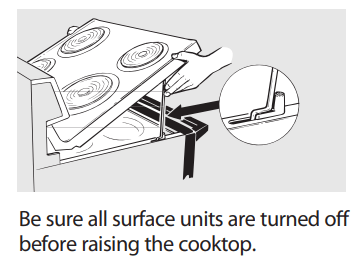
Some models have a cooktop that can be lifted up for easier cleaning. The entire cooktop may be lifted up and supported in the up position.
The surface units do not need to be removed; however, you may remove one to make raising the cooktop easier. There are two side supports that lock into position when the cooktop is lifted up.
After cleaning under the cooktop with hot, mild soapy water and a clean cloth, lower the cooktop. Be careful not to pinch your fingers.
To lower the cooktop, push the rods back and gently lower the cooktop until it rests in place.
NOTE: Do not lift the cooktop on radiant top models. Lifting the cooktop can lead to damage and improper operation of the range.
Surface Units (on coil models)

Be sure all the controls are turned to OFF and the surface units are cool before attempting to remove them.
To clean the surface units, turn the control to the highest setting for a minute. The coils will burn off any soil.
To remove a surface unit:
To remove the drip pans for cleaning, the surface units must be removed first.
Lift the surface unit about 1 inch above the drip pan and pull it out.
Do not lift the surface unit more than 1". If you do, it may not lie flat on the drip pan when you plug it back in.
Repeated lifting of the surface unit more than 1 inch above the drip pan can permanently damage the receptacle.
To replace a surface unit:
Replace the drip pan into the recess in the cooktop. Make sure the opening in the pan lines up with the receptacle.
Insert the terminals of the surface unit through the opening in the drip pan and into the receptacle.
Guide the surface unit into place so it rests evenly.
 Do not immerse the surface units in liquids of any kind.
Do not immerse the surface units in liquids of any kind.
Do not clean the surface units in a dishwasher.
Do not bend the surface unit plug terminals.
Do not attempt to clean, adjust or in any way repair the plug-in receptacle.
Drip Pans (on coil models)
Remove the surface units. Then lift out the drip pans.
Place them in a covered container. Add 1/4 cup ammonia and let soak several hours or overnight. Wash, rinse well and dry.
The drip pans may also be cleaned in the dishwasher.
Clean the area under the drip pans often. Built-up soil, especially grease, may catch fire.
Do not cover the drip pans with foil. Using foil so close to the receptacle could cause shock, fire or damage to the range.
NOTE: Do not clean the drip pans in a self-cleaning oven.
Oven Vent (on coil models)
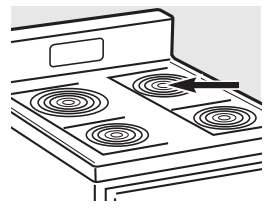
On glass cooktop models, the oven is vented through an opening at the rear of the cooktop.
On coil cooktop models, the oven is vented through an opening under the right rear surface unit.
Never cover the opening with aluminum foil or any other material.
Painted Surfaces (on some models)
Painted surfaces include the sides of the range and the sides of the door trim.
To clean the painted surfaces, use a hot, damp cloth with a mild detergent suitable for these surfaces. Use a clean, hot, damp cloth to remove soap. Dry with a dry, clean cloth.
Do not use steel-wood pads, commercial oven cleaners, cleaning powders or other abrasive cleaners. They will damage the surface.
Stainless Steel Surfaces (on some models)
Do not use a steel wool pad; it will scratch the surface.
To clean the stainless steel surface, use warm sudsy water or a stainless steel cleaner or polish. Always wipe the surface in the direction of the grain. Follow the cleaner instructions for cleaning the stainless steel surface.
To inquire about purchasing stainless steel appliance cleaner or polish, or to find the location of a dealer or MC Commercial Parts Store nearest you, please call our toll-free number:
Glass Window (on some models)
To clean the outside glass finish, use a glass cleaner. Rinse and polish with a dry cloth.
BOWL AND COIL ASSEMBLY (on coil models)

In order to do a right assembly of the bowl and the coil into the cook top you need to insert both components together as shown in the picture.
Avoid inserting components sparely, this will cause wrong assemble issues.
Attention (on coil models)
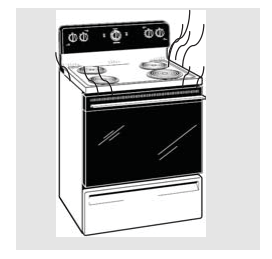
When using the oven is normal to have an increase of temperature on the cooktop surface, based on the fact that the release of heat from the oven is placed on the back right burner/coil of the range.
Cleaning the glass cooktop. (on radiant models)
Normal Daily Use Cleaning
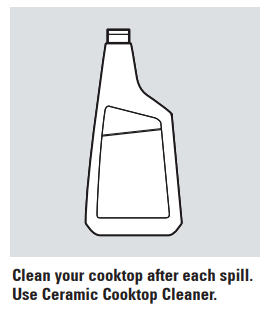
ONLY use Ceramic Cooktop Cleaner on the glass cooktop. Other types of cleaners may not be as effective.
To maintain and protect the surface of your glass cooktop, follow these steps:
- Before using the cooktop for the first time, clean it with Ceramic Cooktop Cleaner. This helps protect the top and makes cleanup easier.
- Daily use of Ceramic Cooktop Cleaner will help keep the cooktop looking new.
- Shake the cleaning cream well. Apply a few drops of Ceramic Cooktop Cleaner directly to the cooktop.
- Use a paper towel for Ceramic Cooktops to clean the entire cooktop surface.
- Use a dry cloth or paper towel to remove all cleaning residue. No need to rinse.
NOTE: It is very important that you DO NOT heat the cooktop until it has been cleaned thoroughly.
Burned-On Residue
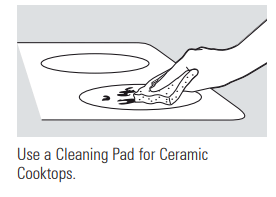
WARNING:
glass surface may occur if you use scrub pads other than those recommended.
- Allow the cooktop to cool.
- Spread a few drops of Ceramic Cooktop Cleaner on the entire burned residue area.
- Using the included Cleaning Pad for Ceramic Cooktops, rub the residue area, applying pressure as needed.
- If any residue remains, repeat the steps listed above as needed.
- For additional protection, after all residue has been removed, polish the entire surface with Ceramic Cooktop Cleaner and a paper towel.
Heavy, Burned-On Residue
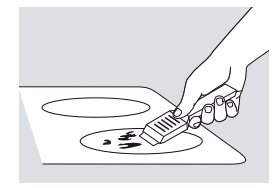
The Ceramic Cooktop Scraper and all recommended supplies are available through our dealers or through a MC Commercial Parts Store.
NOTE: Do not use a dull or nicked blade.
- Allow the cooktop to cool.
- Use a single-edge razor blade scraper at approximately a 45° angle against the glass surface and scrape the soil. It will be necessary to apply pressure to the razor scraper in order to remove the residue.
- After scraping with the razor scraper, spread a few drops of Ceramic Cooktop Cleaner on the entire burned residue area. Use the Cleaning Pad to remove any remaining residue.
- For additional protection, after all residue has been removed, polish the entire surface with Ceramic Cooktop Cleaner and a paper towel.
Metal Marks and Scratches
- Be careful not to slide pots and pans across your cooktop. It will leave metal markings on the cooktop surface.
These marks are removable using the Ceramic Cooktop Cleaner with the Cleaning Pad for Ceramic Cooktops. - If pots with a thin overlay of aluminum or copper are allowed to boil dry, the overlay may leave black discoloration on the cooktop.
This should be removed immediately before heating again or the discoloration may be permanent.
Cooktop Seal
To clean the cooktop seal around the edges of the glass, lay a wet cloth on it for a few minutes, then wipe clean with nonabrasive cleaners.
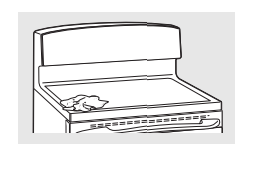
Glass surface—potential for permanent damage.
Sugary spillovers (such as jellies, fudge,candy, syrups) or melted plastics can cause pitting of thesurface ofyourcooktop (not coveredbythewarranty) unless thespill is removed while still hot. Special care shouldbetaken when removing hot substances.
Be sure to use a new, sharp razor scraper.
Do notuse a dull or nicked blade.
Damage from Sugary Spills and Melted Plastic
- Turn off all surface units. Remove hot pans.
- Wearing an oven mitt:
- Use a single-edge razor blade scraper to move the spill to a cool area on the cooktop.
- Remove the spill with paper towels.
- Any remaining spillover should be left until the surface of the cooktop has cooled.
- Don’t use the surface units again until all of the residue has been completely removed.
NOTE: If pitting or indentation in the glass surface has already occurred, the cooktop glass will have to be replaced. In this case, service will be necessary.
To Order Parts

To order CERAMA BRYTE® Ceramic Cooktop Cleaner and the cooktop scraper, please call our toll-free number:
National Parts Centre
800.661.1616
CERAMA BRYTE® Ceramic
Cooktop Cleaner........CERAMABRYTE
CERAMA BRYTE® Ceramic
Cooktop Scraper ................TE05-503
Kit .............................45898
(Kit includes cream and cooktop scraper)
CERAMA BRYTE® Cleaning Pads for Ceramic Cooktops ..........28001
Troubleshooting
Before you call for service…
Troubleshooting Tips
Save time and money! Review the charts on the following pages first and you may not need to call for service.
| Problem | Possible Cause | What To Do |
Radiant Cooktops | ||
| Surface units will not maintain a rolling boil or cooking is not fast enough | Improper cookware being used. |
|
| Surface units do not work properly | A fuse in your home may be blown or the circuit breaker tripped. |
|
| Cooktop controls improperly set. |
| |
| Scratches (may appear as cracks) on cooktop glass surface | Incorrect cleaning methods being used. Cookware with rough bottoms being used or coarse particles (salt or sand) were between the cookware and the surface of the cooktop. Cookware has been slid across the cooktop surface. |
|
| ||
| Areas of discoloration on the cooktop | Food spillovers not cleaned before next use. |
|
| Hot surface on a model with a light-colored glass cooktop. |
| |
| Plastic melted to the surface | Hot cooktop came into contact with plastic placed on the hot cooktop. |
|
| Pitting (or indentation) of the cooktop | Hot sugar mixture spilled on the cooktop. |
|
Frequent cycling off and on of surface units Surface indicator lights turn on, but surface units do not work | Improper cookware being used. The self-clean cycle has been set. |
|
| Surface unit stops glowing when turned to a lower setting | This is normal. The unit is still on and hot. | |
| Coil Cooktops | ||
| Surface units not functioning properly | The surface units are not plugged in solidly. |
|
| The surface unit controls improperly set. |
| |
| The drip pans are not set securely in the cooktop. |
| |
| Oven–All Models | ||
| Oven light does not work | Light bulb is loose or defective. |
|
| Switch operating light is broken. |
| |
| Oven will not work | Plug on range is not completely inserted in the electrical outlet. |
|
| A fuse in your home may be blown or the circuit breaker tripped. |
| |
| Oven controls improperly set. |
| |
| On self-cleaning models, door left in the locked position. |
| |
| Food does not bake or roast properly | Oven controls improperly set. |
|
| Rack position is incorrect or the rack is not level. |
| |
| Incorrect cookware or cookware of improper size being used. |
| |
| Oven thermostat needs adjustment. |
| |
| No power supply from convenience outlet on top of backguard (on some models) | Small appliance plug is not completely inserted in the convenience outlet. |
|
| The backguard is too hot and the convenience outlet breaker has tripped. |
| |
| Displayed warning message "turn OFF brnr" | Surface unit is on. |
|
| Food does not broil properly | Improper rack position being used. |
|
| Food being cooked in a hot pan. |
| |
| Aluminum foil used on the broiling pan and grid has not been fitted properly and slit as recommended. |
| |
| In some areas the power (voltage) may be low. |
| |
| Control signals after entering cooking time or delay start | You forgot to enter a bake temperature or cleaning time. |
|
| Display flashes "bAd" then "linE" with a loud tone | The installed connection from the house to the unit is miswired. |
|
| Surface units do not work | There has been a main power supply surge and/or a power interruption and surge |
|
| The words "CLOSE DOOR" flashes or scrolls in the display | This is a normal condition. The "CLOSE DOOR" is a reminder message to keep the oven door closed during broil mode |
|
| Oven temperature too hot or too cold | Oven thermostat needs adjustment. |
|
| Clock and timer do not work | Plug on range is not completely inserted in the electrical outlet. |
|
| A fuse in your home may be blown or the circuit breaker tripped. |
| |
| Oven controls improperly set. |
| |
| Display goes blank | A fuse in your home may be blown or the circuit breaker tripped. |
|
| The clock is turned off from showing in the display. |
| |
| Oven door is crooked | The door is out of position. |
|
| Oven makes clicking noise | This is the sound of the heating element turning off and on during cooking functions. |
|
| "F—and a number or letter" flash in the display | You have a function error code. |
|
| If the function code repeats: |
| |
| Power outage clock flashes | Power outage or surge. |
|
| Display flashes | Power failure. |
|
| Unable to get the display to show "SF" | Oven control pads were not pressed properly. |
|
| "Burning" or “oily” odor emitting from the oven vent | This is normal in a new oven and will disappear in time. |
|
| Strong odor | An odor from the insulation around the inside of the oven is normal for the first few times the oven is used. |
|
| Self-Cleaning Models | ||
Oven will not self-clean | The oven temperature is too high to set a self-clean operation. |
|
| Oven controls improperly set. |
| |
| Oven door is not in the locked position. |
| |
Oven starts a self-clean cycle when you wanted to bake, roast or broil | Oven door locked during cooking. |
|
| "Crackling" or "popping" sound | This is the sound of the metal heating and cooling during both the cooking and cleaning functions. |
|
| Excessive smoking during a clean cycle | Excessive soil. |
|
| Oven door will not unlock | Oven too hot. |
|
| Oven not clean after a clean cycle | Oven controls not properly set. |
|
| Oven was heavily soiled. |
| |
See other models: JCGBS60DEKWW JCGB745SPSS PC2B940SEJSS PVM2155SHC PCS940BMTS
